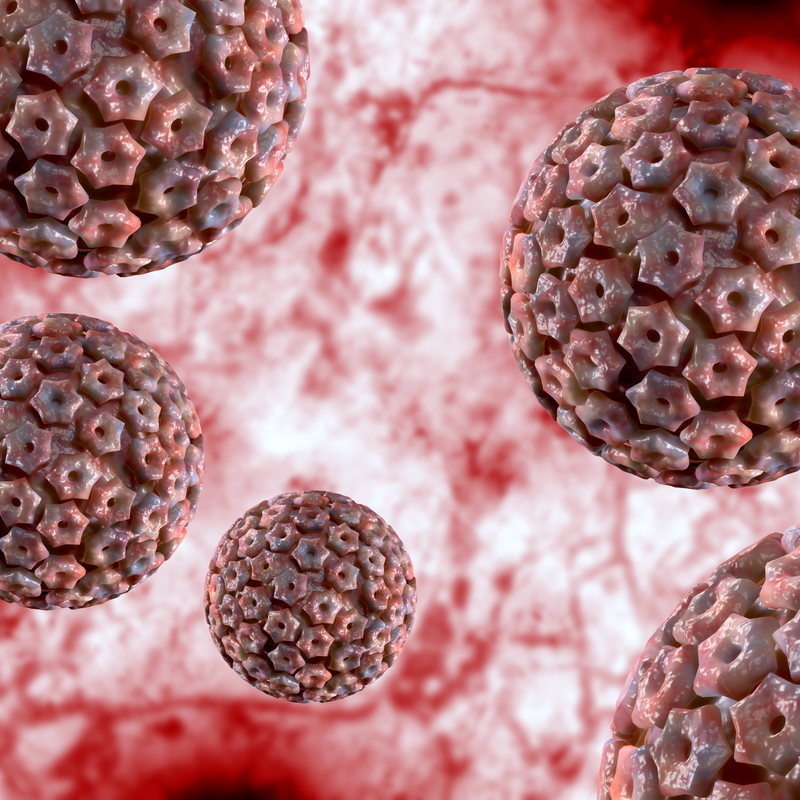
What is herpes simplex type 1 (HHV-1)?
The herpes simplex virus type 1 is a so-called DNA virus and belongs to the family of herpes viruses. In humans, the virus causes an infection simply called herpes simplex, which in most cases is accompanied by skin rashes and mucous membrane rashes, and also forms blisters in most people affected. These infections are predominantly triggered in the facial area, or more precisely in the mouth area.
What is the morphology of herpes simplex type 1 (HHV-1)?
The virus has double-stranded, linear DNA and has a size of about 154 kB. The capsid of the virus is icosahedral and is composed of 162 capsomeres. It has an envelope made of a lipid-containing membrane. The so-called tequment is located between the capsid and the viral envelope.
How common is herpes simplex type 1 (HHV-1)?
The virus is spread all over the world. There are no seasonal variations. Women are affected slightly more often than men. About 70 % of the entire population carries the virus.
How is herpes simplex type 1 (HHV-1) transmitted?
The virus is transmitted from person to person via droplet infection . In most cases, this happens through saliva. It is not uncommon for an infection to occur as early as childhood. But the virus can also enter the body through smear infection, i.e. sharing cutlery or glasses, touching the herpes and from the mother to the child during birth.
What are the symptoms of herpes simplex type 1 (HHV-1)?
The most common symptoms of this virus are burning and itching blisters that form especially often on the lips and in the mouth area . But they can also form in the genital area. But such blisters can also appear in the genital area, which can then cause pain when urinating, fever, local pain and swollen lymph nodes. Severe courses can lead to infections of the cornea in the eyes. An infection in newborns is very severe in many cases and not infrequently even fatal. In about 80 % of those infected, an infection with the virus is completely asymptomatic.
How is herpes simplex type 1 (HHV-1) diagnosed?
Usually one look from a doctor is enough to make the diagnosis of herpes simplex, because the characteristic formation of vesicles usually means that a doctor can only come up with one diagnosis. But the virus can also be detected in the blood using HSV-1 antibodies. Especially during pregnancy, this antibody detection is carried out .
How is herpes simplex type 1 (HHV-1) treated?
First of all Herpes Simplex Type 1 (HHV-1) is considered a non-curable disease. In most cases, sufferers are treated with symptomatic and antiviral medications. These drugs can significantly reduce the frequency of recurrences and reduce the duration of the attacks. After all symptoms have healed, the viruses retreat into the cells of the nerves and remain there for life. The viruses are often reactivated again, especially if the immune system is already weakened . The relapses can occur with or without symptoms. Especially people who suffer from an immunodeficiency disease are more often affected by such episodes. But stress, psychological strain and depression can also put so much strain on the immune system that the viruses break out again and again and lead to recurrences.
What complications can occur with herpes simplex type 1 (HHV-1)?
In rare cases, herpes Simplex type 1 (HHV-1) leads to inflammation of the brain, which can often be life-threatening. Children in particular often die from this complication, especially newborns who get the virus transmitted by their mothers at birth .
How can herpes simplex type 1 (HHV-1) be prevented?
There is currently no vaccination against the virus. The following measures can help prevent the viral disease:
- Reduce stress,
- Strengthen your immune system,
- Get enough sleep and rest,
- Avoid strong UV radiation as much as possible,
- Counteract cracked and dry skin, such as with creams and chapstick,
- Avoid nicotine.
General preventive measures:
- If the disease is in an acute phase, avoid kissing and oral sex.
- Do not share anything that has been in contact with the blisters with other people, such as eating utensils and glasses. If possible, use disposable towels instead of towels and flannels.
- Blisters should not be touched or scraped off.
- Pay attention to general hygiene.
- The fluid from the blisters should not get into the eyes under any circumstances.
- Always apply sunscreen, especially at the seaside and in the mountains.
Special care should be taken with newborns and babies:
- Parents of infants or even newborns should wear a mouth guard while they have the virus in an active state when they are near the child.
- If a pregnant woman is found to be infected for the first time in the clinic, she should be isolated from others.
- On a neonatal unit, efficient hospital hygiene must be maintained, including proper hand hygiene, nappy hygiene and regular gown changes.
- In case of a new outbreak of the disease, the infected person must observe strict hand hygiene, ideally washing hands with soap and lukewarm water and disinfecting them afterwards.
- If the nipples of an infected mother are affected, the child should not be breastfed. If the mother has blisters on her lips, she must unfortunately refrain from cuddling and kissing. When breastfeeding, the mother should wear a mouthguard.
